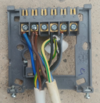Although that obviously makes sense, where do the rules/regs/laws actually say that? If I 'smashed up' one of my CUs, could I then replace it without having to 'notify' the work?No it has been always been permissible to do emergency work without informing LABC first.
Plugwash was talking about England - where, as he said, most/all rented properties should have had their first 'landlord EICR' by now.No not started yet, does not come in until 1st December.
I don't know why you keep saying this because it clearly was not the intent of the legislators (at least, for England), The official guidance document for landlords in relation to the legislation (in England) saysThe problem is can't actually see where it says must be done in any law, the guides to the law says it must be done, but enter EICR or PIT in the "Find in page" and every page reports not on the page, the likely applies equally in England and Wales, so as with English regulations it includes current using equipment like immersion heater, boiler, cooker, and dishwasher, washing machine, and drier if not on wheels. I can't remember the weight at which without wheels not classed as portable think 18 kg, and a tumble drier is over that.
What about electrical appliances like cookers, fridges, televisions etc?
The Regulations do not cover electrical appliances, only the fixed electrical installations. We recommend that landlords regularly carry out portable appliance testing (PAT) on any electrical appliance that they provide and then supply tenants with a record of any electrical inspections carried out as good practice. Tenants are responsible for making sure that any of their own electrical appliances are safe.
Kind Regards, John


